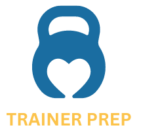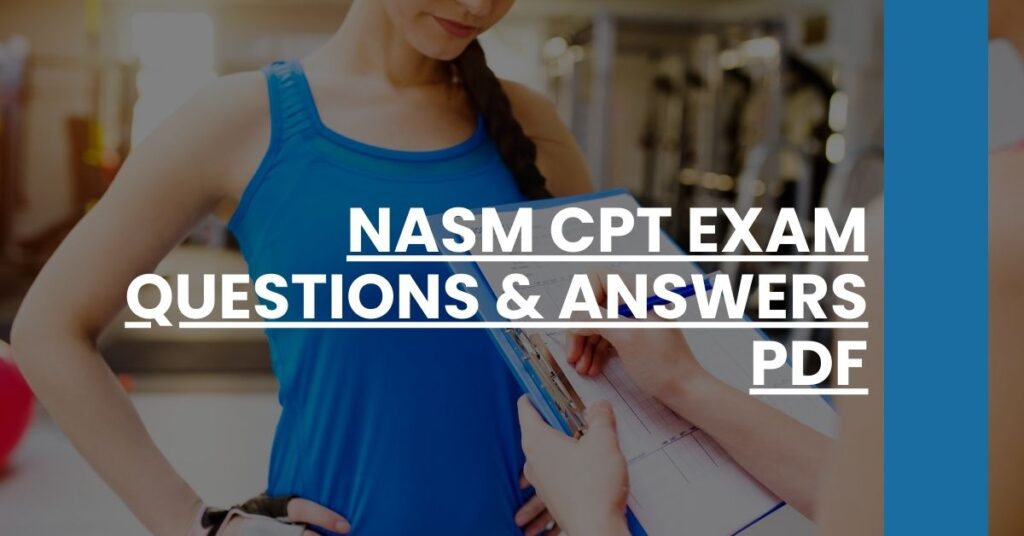Navigating the NASM CPT Exam can feel overwhelming, especially when you’re confronted with an abundance of information. Trust me, I know the importance of finding reliable study materials like a NASM CPT Exam Questions & Answers PDF. These PDFs not only make studying more structured, but they also give you quick access to the most relevant questions.
To ease the process, I’ve put together a comprehensive guide to help you streamline your preparation, which covers:
- The benefits of using a NASM CPT Exam Questions & Answers PDF
- Reliable sources for finding updated NASM CPT Exam PDFs
- Practical tips for effective studying with NASM CPT PDFs
Let’s make your study sessions more efficient and less stressful with these essential insights.
- Understanding the NASM CPT Exam
- Why Access NASM CPT Exam Questions & Answers in PDF Format?
- Where to Find Reliable NASM CPT Exam PDFs
- The Structure of NASM CPT Exam Questions
- Sample NASM CPT Exam Questions and Answers
- How to Effectively Use NASM CPT Exam PDFs for Studying
- Common Mistakes to Avoid When Studying from PDFs
- Technical Tips for Managing Your NASM CPT PDF Resources
- Conclusion
Understanding the NASM CPT Exam
The Importance of the NASM CPT Certification
The National Academy of Sports Medicine (NASM) Certified Personal Trainer (CPT) certification is a credential that fitness professionals around the world hold in high regard. The NASM-CPT certification is accredited by the National Commission for Certifying Agencies (NCCA), ensuring it meets rigorous standards.
Exam Content and Structure
The NASM CPT exam assesses your knowledge and skills across six key domains focused on essential aspects of personal training:
- Domain 1: Basic and Applied Sciences and Nutritional Concepts
This domain focuses on anatomy, physiology, biomechanics, and nutrition basics, providing a foundational knowledge crucial for understanding human movement and dietary effects. - Domain 2: Assessment
You’ll be tested on your ability to perform fitness assessments, understand health appraisals, and evaluate client capabilities and needs. - Domain 3: Program Design
Creating effective fitness programs tailored to individual needs is pivotal. This domain covers different phases of the NASM Optimum Performance Training™ (OPT™) model. - Domain 4: Exercise Technique and Training Instruction
Ensuring proper exercise performance and instructing clients on safe and effective techniques are focal points here. - Domain 5: Client Relations and Behavioral Coaching
This part emphasizes building strong relationships, creating motivational environments, and using behavioral change strategies. - Domain 6: Professional Development and Responsibility
Understanding professional roles, ethics, continuing education, and maintaining certification comprises this domain.
Success in this exam requires not only theoretical knowledge but also the practical application of principles.
Why Access NASM CPT Exam Questions & Answers in PDF Format?
Advantages of Using PDFs
PDF documents are a highly beneficial medium for studying for the NASM CPT exam. Let’s explore why this format is so effective:
- Offline Accessibility: You can download the PDF files and access them without an internet connection anytime and anywhere. This is incredibly convenient for study on the go.
- Ease of Distribution: Sharing PDFs is straightforward. You can easily send them to peers or educators for collaborative study sessions.
- Annotation Capabilities: Most PDF readers allow you to highlight text, add notes, and bookmark pages, which can aid in emphasizing key points and organizing your study notes.
Moreover, high-quality NASM CPT Exam Questions & Answers PDFs often come with features like 90 Days Free Update and a 30 Days Money Back Pass Guarantee, making them versatile tools for preparation.
Where to Find Reliable NASM CPT Exam PDFs
Official NASM Resources
The official NASM website is one of the best places to find reliable study materials and resources tailored specifically for the NASM CPT exam. You can access practice exams, study guides, and other essential resources that will guide you through your study journey.
Third-Party Educational Platforms
Several reputable educational platforms also provide high-quality NASM CPT Exam questions and answers in PDF format:
- Study.com: Known for its comprehensive study guides and interactive content, Study.com offers materials specifically designed for NASM CPT exam preparation. They provide in-depth analysis and explanations to help you understand and retain the material.
Online Communities
Engaging with online communities like Reddit or NASM-specific forums can also yield useful resources. Often, fellow candidates share valuable insights, study tips, and occasionally, sample questions and answers that can be compiled into PDF format.
The Structure of NASM CPT Exam Questions
Question Types
The NASM CPT exam consists of 120 multiple-choice questions, and you have two hours to complete it. The questions are designed to test not only your knowledge but your ability to apply that knowledge practically. Here’s a breakdown of the types of questions you can expect:
- Multiple Choice: The core of the exam, testing your understanding across all six domains.
- Practical Scenarios: Questions that require applying knowledge to real-world situations, evaluating client scenarios, and designing appropriate responses.
- Situational Judgement Questions: Questions that assess your decision-making skills and understanding of professional conduct in various situations.
Sample NASM CPT Exam Questions
Providing sample questions can help you get a feel for the exam format. Here are a few examples:
- Q: What is the correct order of the stages of change in the Transtheoretical Model?
- A: Precontemplation, contemplation, preparation, action, maintenance.
- Q: Which nutrient is the primary source of energy during high-intensity exercise?
- A: Carbohydrates.
By understanding the structure and types of questions, you’ll be better prepared to tackle what comes your way on exam day.
Sample NASM CPT Exam Questions and Answers
Sample Questions
Providing sample questions can help you get a feel for the exam format. Here are a few examples:
- Which nutrient is the primary source of energy during high-intensity exercise?
- Answer: Carbohydrates.
- What is the correct order of the stages of change in the Transtheoretical Model?
- Answer: Precontemplation, contemplation, preparation, action, maintenance.
- When spotting a client performing a bench press, where should the spotter’s hands be placed?
- Answer: The spotter’s hands should be close to the client’s wrists.
- Which type of flexibility training is most appropriate during the stabilization level of the OPT model?
- Answer: Corrective flexibility.
Answer Explanation
Understanding the rationale behind correct answers is crucial. Let’s break down the answers to these sample questions:
- Carbohydrates as Energy Source: Carbohydrates are quickly metabolized to provide energy for high-intensity activities, making them the body’s preferred fuel during such exercises.
- Stages of Change: The Transtheoretical Model’s stages represent a progression of behavioral change, moving from lack of awareness (precontemplation) to sustained action (maintenance).
- Spotting During Bench Press: Effective spotting techniques ensure client safety by providing physical support and preventing the barbell from falling in case of muscle fatigue.
- Corrective Flexibility: During the stabilization level, corrective flexibility focuses on improving muscle imbalances and correcting altered joint motion.
These sample questions reflect the competency areas you’ll encounter on the NASM CPT exam, emphasizing practical application and theoretical understanding.
How to Effectively Use NASM CPT Exam PDFs for Studying
Study Scheduling
Creating an effective study plan is crucial. A well-structured schedule ensures you cover all topics and reinforce your knowledge systematically.
- Break Down Topics by Day: Allocate specific domains to different days. For example, Mondays and Wednesdays can be dedicated to Basic and Applied Sciences.
- Incorporate Daily Reviews: At the end of each study session, review key points from the day to reinforce learning.
- Schedule Practice Tests: Regular practice exams help identify weak areas and track progress. Schedule these tests bi-weekly.
Active Learning Techniques
Incorporate active learning methods to enhance retention and understanding.
- Highlight and Annotate PDFs: Use the annotation features of your PDF reader to highlight important information and jot down notes.
- Summarize in Your Own Words: Paraphrase key concepts and write summaries. This practice helps with deeper understanding and retention.
- Teach What You Learn: Explain topics to a study partner or even to yourself. Teaching reinforces your knowledge and uncovers gaps in your understanding.
Practice Under Exam Conditions
To reduce exam-day anxiety and familiarize yourself with the test environment, practice under conditions that mimic the actual exam.
- Timed Practice Tests: Set a timer to simulate the 2-hour exam duration and complete practice tests within this timeframe.
- Minimize Distractions: Find a quiet place, free from interruptions, to simulate exam conditions as closely as possible.
Common Mistakes to Avoid When Studying from PDFs
Over-Reliance on PDFs
While PDFs are handy, relying solely on them isn’t enough. Here are some pitfalls to avoid:
- Neglecting Practical Application: It’s essential to put theory into practice. Make sure you integrate physical exercise techniques and client assessment methods into your routine.
- Ignoring Supplementary Resources: Diversify your study materials. Include videos, peer study groups, and textbooks to cover all learning styles.
- Skipping Physical Books: Don’t overlook the advantages of traditional books. The tactile experience can sometimes help better retention of information.
Poor Organization
Organizing your study materials can significantly impact your efficiency:
- Unorganized Files: Keep your PDFs well-organized in folders with clear labels to quickly find the required documents.
- Lack of Study Plan: Without a structured study plan, you might miss critical topics or spend too much time on certain sections.
Technical Tips for Managing Your NASM CPT PDF Resources
Efficient Storage and Access
Managing your digital resources effectively is crucial for uninterrupted study sessions:
- Cloud Storage: Use services like Google Drive or Dropbox to store your PDFs. This makes your materials accessible from any device and prevents data loss.
- Backup Regularly: Have a backup plan. Regularly update a secondary storage option, like an external hard drive, to avoid losing your study materials.
- File Naming Conventions: Adopt a clear and consistent naming convention for your PDFs. For example, “01_Basic_Sciences.pdf” makes it easy to identify and locate specific topics.
Annotation and Note-Taking
Make the most out of your PDFs by using annotation tools:
- Highlight Key Points: Most PDF readers allow highlighting text, which helps emphasize critical information.
- Use Sticky Notes: Add digital sticky notes to jot down thoughts, explanations, and summaries.
- Bookmark Pages: Bookmark important sections for quick reference during revision.
Begin integrating these technical tips into your routine to ensure you maximize the utility of your NASM CPT Exam Questions & Answers PDFs.
Conclusion
Studying for the NASM CPT Exam requires a well-rounded approach. By incorporating structured schedules, engaging in active learning, managing digital resources efficiently, and avoiding common pitfalls, you set yourself up for success. Leveraging the advantages of NASM CPT Exam Questions & Answers PDFs will help streamline your preparation process. Remember, consistent practice and diverse study methods are your keys to mastering the exam’s material effectively.

